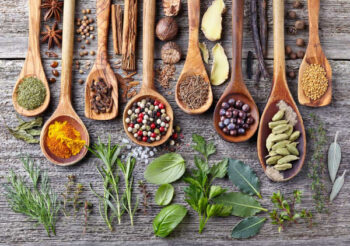 By Sayer Ji
By Sayer Ji
Contributing writer for Wake Up World
Over the years, researchers have become increasingly interested in the effects of diet and natural compounds on human health, finding that many herbs and spices are equally or more effective than many conventional medicines and treatments, and often present far fewer adverse effects while being more cost-effective. Here are five herbs and spices you can add to your diet to turn ordinary meals into nutrient-dense “supermeals”:
1. Garlic
Garlic, a member of the Allium family, is known for its anti-inflammatory effects, but recent research has found that garlic has immunoregulation properties that fight against the development of conditions like obesity, cardiovascular disease and cancer.[i] Garlic’s strong immunostimulation effects work by modulating cytokine secretion and directly stimulating immune cells, promoting efficient cellular response to viral infections and other diseases.[ii]
Additional research on the benefits of garlic for cardiovascular disease prevention and therapy shows that garlic intake increases fibrinolytic activity in both healthy patients and those who have had a heart attack, reducing the risk of a blood clot.[iii] Garlic also works to decrease serum lipids levels and blood pressure, both of which are associated with cardiovascular disease.[iv],[v]
Finally, multiple studies show that garlic may also prevent neurodegenerative disease progression. Garlic’s neuroprotective effects are probably due to its antioxidant, anti-apoptotic and anti-atherogenic benefits, which work together to prevent the risk of diseases like Alzheimer’s, Parkinson’s, Huntington’s and motor neuron diseases.[vi]
2. Ginger
Even among lay individuals, ginger is well-known for its gastrointestinal benefits and is widely used as a natural remedy for stomachache, nausea, vomiting, belching, diarrhea and other gastric ailments, including irritable bowel syndrome.[vii]
Ginger and its metabolites accumulate in the digestive tract, which explains its potent digestive benefits, but research has demonstrated that ginger’s therapeutic potential extends beyond its gastrointestinal benefits.[viii]
Several of the biological constituents of ginger, including gingerol and zingerone, may reduce the risk of various types of cancer via their anti-tumor properties and antioxidant activity.[ix] By up-regulating the tumor repression gene, these biological constituents can inhibit tumor growth or even prevent their occurrence.
These findings have been demonstrated for both breast and prostate cancers, but researchers believe that ginger may be a novel therapeutic approach to preventing and treating a variety of cancers, with fewer side effects than the conventional treatment methods such as chemotherapy or radiotherapy drugs.[x]
3. Turmeric
Like ginger, the benefits of turmeric and its main constituent curcumin are well-known. Curcumin has been studied extensively for its antimicrobial, anti-inflammatory and antioxidant properties, and researchers have demonstrated that turmeric supplementation may prevent cardiovascular disease and produce neuroprotective effects.[xi]
Because of its anti-inflammatory effects, curcumin is a potential treatment for inflammatory bowel disease, pancreatitis, arthritis and breast and prostate cancers.[xii],[xiii] Additionally, curcumin boasts neuroprotective properties and may reduce the risk or delay the development of Alzheimer’s, multiple sclerosis, prion diseases, Down syndrome and autism.[xiv]
While adverse effects associated with the consumption of curcumin or turmeric are rare, the bioavailability of curcumin does present some challenges. By combining turmeric with black pepper, which contains the alkaloid piperine, it’s possible to increase the absorption rate of curcumin.[xv],[xvi]
[pro_ad_display_adzone id=”110030″]
4. Chili Pepper
Capsaicin, a phytochemical in chili peppers that impacts the spiciness, is known for promoting vascular health, as well as improving metabolic syndrome, diabetes, obesity and stroke risk.[xvii],[xviii]
Capsaicin’s effects on these diseases seem to be multifaceted: for example, while a reduction of obesity decreases the risk of cardiovascular disease, capsaicin also works to improve coronary blood flow, improving overall heart health. Also, capsaicin’s antimicrobial properties seem to positively impact the health of the gut microbiome, indirectly improving the risk of metabolic syndrome.[xix]
In addition to these benefits, researchers believe that the consumption of chili peppers could drastically improve micronutrient deficiency.[xx] Micronutrients such as vitamins, minerals, antioxidants and trace elements are severely lacking from the global diet and are necessary for the prevention of various diseases, healthy early childhood development, and the breakdown and absorption of macronutrients.[xxi] Micronutrients contained in chili peppers include:[xxii]
|
Vitamin A |
Vitamin C |
|
Vitamin E |
Magnesium |
|
Folate |
Potassium |
|
Copper |
Manganese |
|
Molybdenum |
Iron |
Micronutrients cannot be synthesized by the human body and must be obtained through diet, and researchers have been impressed with the potency and high number of these compounds in chili peppers, reporting, “Significant portions of recommended daily nutrients could be supplied by the incorporation of nutrient?rich chili pepper into human diets.” [xxiii],[xxiv]
5. Saffron
Saffron, like turmeric, is a golden spice with therapeutic properties, although it is less well-known. Saffron has been studied for its beneficial effects on gastrointestinal diseases, the gut microbiome, the stomach, hepatitis, colitis and cancer, among other disorders.[xxv]
In addition to these benefits, saffron may be a beneficial natural treatment for mild to moderate depression, and in one study was equally effective as popular antidepressant drugs imipramine and fluoxetine.[xxvi]
While researchers aren’t sure exactly how saffron produces these effects, it seems that saffron increases mood-elevating chemicals like serotonin in the brain by inhibiting serotonin reuptake, keeping serotonin levels high and prolonging serotonin’s positive effects.[xxvii]
Adding these five herbs and spices to your daily cooking routine is the easiest way to procure their benefits. By sprinkling on your roasted vegetables, adding to smoothies or shakes, or including them in your marinades and dressings, you can drastically increase the nutritional content of your everyday meals.
To learn more about the potent benefits of these ingredients and others in your pantry, visit the GreenMedInfo research database on culinary herbs and spices.
References:
[i] J Immunol Res. 2015; 2015: 401630.
[ii] J Immunol Res. 2015; 2015: 401630.
[iii] Avicenna J Phytomed. 2014 Jan-Feb; 4(1): 1-14.
[iv] Evid Based Complement Alternat Med. 2013; 2013: 125649.
[v] Indian J Clin Biochem. 2011 Jan; 26(1): 96-97.
[vi] Libyan J Med. 2008; 3(1): 23-33.
[vii] Food Sci Nutr. 2019 Jan; 7(1): 96-108.
[viii] Bode AM, Dong Z. Herbal Medicine: Biomolecular and Clinical Aspects. 2nd edition. Boca Raton (FL): CRC Press/Taylor & Francis; 2011. Chapter 7
[ix] Int J Physiol Pathophysiol Pharmacol. 2014; 6(2): 125-136.
[x] Int J Physiol Pathophysiol Pharmacol. 2014; 6(2): 125-136.
[xi] Adv Biomed Res. 2018; 7: 38.
[xii] AAPS J. 2013 Jan; 15(1): 195-218.
[xiii] Altern Med Rev. 2009 Jun;14(2):141-53.
[xiv] Biofactors. 2019 Sep;45(5):666-689. doi: 10.1002/biof.1533. Epub 2019 Jun 11.
[xv] AAPS J. 2013 Jan; 15(1): 195-218.
[xvi] Foods. 2017 Oct; 6(10): 92.
[xvii] PLoS One. 2017; 12(1): e0169876.
[xviii] Open Heart. 2015; 2(1): e000262.
[xix] PLoS One. 2017; 12(1): e0169876.
[xx] Food Sci Nutr. 2018 Nov; 6(8): 2239-2251.
[xxi] Food Sci Nutr. 2018 Nov; 6(8): 2239-2251.
[xxii] Food Sci Nutr. 2018 Nov; 6(8): 2239-2251.
[xxiii] PLoS One. 2016; 11(8): e0161464.
[xxiv] Food Sci Nutr. 2018 Nov; 6(8): 2239-2251.
[xxv] Nutrients. 2019 May; 11(5): 943.
[xxvi] Pharmacogn Rev. 2013 Jan-Jun; 7(13): 61-66.
[xxvii] J Pharm Bioallied Sci. 2018 Oct-Dec; 10(4): 173-180.
About the author:
Sayer Ji is the founder of Greenmedinfo.com, a reviewer at the International Journal of Human Nutrition and Functional Medicine, Co-founder and CEO of Systome Biomed, Vice Chairman of the Board of the National Health Federation, and Steering Committee Member of the Global Non-GMO Foundation.
© 2020 GreenMedInfo LLC. This work is reproduced and distributed with the permission of GreenMedInfo LLC. Want to learn more from GreenMedInfo? Sign up for their newsletter here.
Psilocybin mushrooms, also known as “magic mushrooms,” are reemerging as powerful tools for emotional and spiritual healing. Backed by scientific research, these sacred medicines have shown promise in addressing anxiety, depression, PTSD, and more. However, working with psilocybin requires preparation, intention, and integration to ensure safe and meaningful experiences.
In this 7-week course, a leading herbalist and expert in psilocybin will guide you through every step of the journey. You’ll learn the history, science, and best practices for safe use and how to prepare for your experience, set intentions, and integrate insights into your daily life. Whether you’re curious or ready to take the next step, this course offers the support you need.
Start your journey toward emotional wellness and spiritual growth today. Sign up for this transformative online event and discover how psilocybin mushrooms can help you unlock your fullest potential. Don’t wait — take the first step now!
If you’ve found value in our articles, we invite you to support the release of our brand-new book, “Gratitude Practices for Kids: A Practical Guide for Adults to Instill a Spirit of Appreciation and Positivity in the Next Generation.“
“Gratitude Practices for Kids” brings together over 25 innovative and accessible practices designed to enhance gratitude in everyday life. This comprehensive guide is backed by 17 scientific studies, ensuring each concept is grounded in research, underscoring our commitment to nurturing growth, emotional intelligence, and positive interactions between adults and children.
We encourage you to opt for the paperback version to celebrate this new release. Dive into its fresh pages away from digital distractions, allowing you to immerse yourself in the transformative practices it offers.
Over recent years, Wake Up World has faced significant online censorship, which has impacted our financial ability to operate. Moving into book publishing represents a strategic step to secure the ongoing funds needed to continue our mission. By purchasing Gratitude for Kids, you help us keep our content free and accessible to everyone, avoiding needing a paywall. With over 8,500 articles published in the last 13 years, we remain dedicated to keeping our valuable content open to all.









